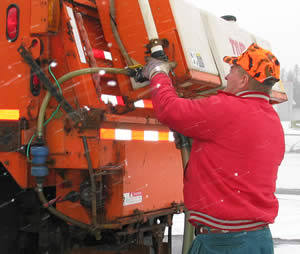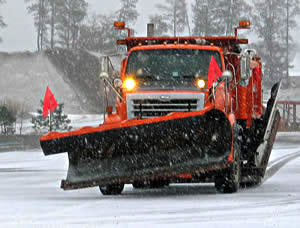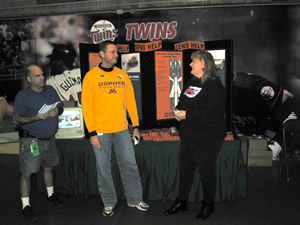 |
Filling one of many brine tanks used for pre-wetting, Dick Bordwell,
a senior transportation generalist at Brainerd, prepares a snowplow
to take on the Nov. 3 storm. Photo by Jenny
Seelen.
|
Mn/DOT’s maintenance forces expanded their use of snow-fighting techniques
such as anti-icing and the use of new de-icing materials during the first major
statewide snowstorm on Nov. 3, said Mark Wikelius, state maintenance engineer.
Crews from rural truck stations and those in the Twin Cities metro area uncorked
de-icers made from commodities such as corn and sugar beets mixed with magnesium
chloride. These chemicals are applied before a storm begins to keep snow from
bonding with the pavement, making removal easier and faster.
More truck stations now use pre-wetting, the process of treating the sand/salt
mixture with brine or other dissolved salts to boost melting capability and
help the mixture adhere to the road surface.
The storm extended from northwestern Minnesota to southern Minnesota dropping
as many as 10 inches of snow near Ortonville to about 1.5 inches in the Twin
Cities area.
The storm also saw the initiation of Mn/DOT’s revised snow and ice control
guidelines, Wikelius said. The new guidelines seek cost savings and other efficiencies
by reducing the number of overtime hours worked by maintenance crews and using
innovations such as anti-icing more widely.
The guidelines continue current priorities to achieve bare lanes on interstate
freeways and state highways to achieve desired results from the human and financial
resources invested.
Revised snow and ice control guidelines
Priorities for plowing interstate freeways and state highways are as follows:
- Highways that have the highest traffic volumes (e.g., urban interstate freeways)
have the highest priority for plowing--achieve bare lanes within one to three
hours after the end of a snowfall and blowing snow.
- Major highways with high traffic volumes--second priority for plowing; achieve
bare lanes in two to five hours after the end of a snowfall.
- Two-lane rural highways rank third in priority--achieve bare lanes within
four to nine hours after the end of the snowfall.
- Highway lanes with lower traffic volumes (800 to 2,000 vehicles per day)--bare
lanes achieved within 6 to12 hours after snow ends.
- Highways with fewer than 800 vehicles per day--bare lanes within 36 hours
after snowfall ends.
 |
Larry Paige, a senior transportation generalist at Brainerd, drives
out of the truck station to begin plowing during the Nov. 3 snowstorm.
Photo by Jenny Seelen.
|
Mn/DOT officials stress that plowing operations will begin as soon as possible
on all state highways, but the intensity of the plowing and the time needed
to achieve bare lanes will vary by highway traffic category. In addition, highways
with low traffic volumes in rural areas take longer to clear because they may
be recovered quickly by drifts. They also lack the level vehicular traffic that
can help achieve and retain bare pavement conditions.
In the Metro District, for example, snowplow crews now work three eight-hour
shifts instead of two 12-hour shifts. Metro’s snowplowing schedule calls
for using 40 percent of employees working from 3:30 a.m. until noon, 40 percent
plowing from noon to 8:30 p.m. and 20 percent working through the night. The
morning and evening shifts are staffed more strongly to provide service during
peak traffic hours.
Sue Mulvihill, Metro’s maintenance engineer, said the night shift includes
about 60 employees instead of 80 as in past years.
She said, however, that staffing will be adjusted if weather conditions warrant.
“If we get a heavier winter, we may be adjusting our plan. We still feel
very strongly that the safety of the traveling public is most important,”
she said.
Greater Minnesota districts have also adjusted their schedules to reduce the
number of overtime hours.
Mankato/District 7, for example, plans to use two eight-hour shifts, increase
the level of anti-icing, cut the amount of salt used and leave snow and ice
accumulated in non-hazardous areas until they can be removed without the use
of overtime, said Rebecca Arndt, district public affairs coordinator.
The storm arrived just two days after Mn/DOT’s winter work zone safety
awareness event at the University of Minnesota’s football game at the
Metrodome in Minneapolis and on the first day of Minnesota’s Winter Hazard
Awareness Week.
 |
Awaiting a half-time surge of U of M Gopher football fans at the Metrodome,
Gary Ruud, Communications; Kevin Walker, Metro District Public Affairs,
and Judy Jacobs, District 4 public affairs coordinator, get ready to
show a video and give away brochures promoting safe winter driving.
Mn/DOT hosts the annual event to kick off its winter work zone safety
campaign.Photo by Kent Barnard.
|
The campaign focused on winter driving safety on Nov. 8.
The campaign urges motorists to drive according to prevailing weather conditions,
use extra caution when snowplows are operating and to check weather and road
conditions before traveling.
Bob Winter, director of the District Operations Division, said the emphasis
on winter driving is a needed reminder that motorists share the responsibility
for safe winter driving with Mn/DOT and other public agencies that clear the
state’s streets, roads and highways.
“Mn/DOT people will be doing our best to provide safe travel this winter
on the state’s highways,” Winter said. "When it snows, clearing
the roads to allow safe travel is always our first priority.”
By Craig Wilkins
|



